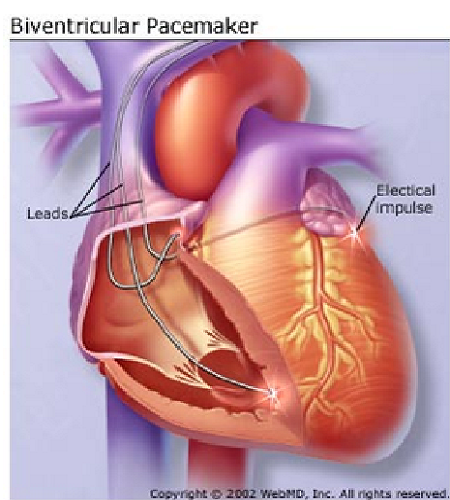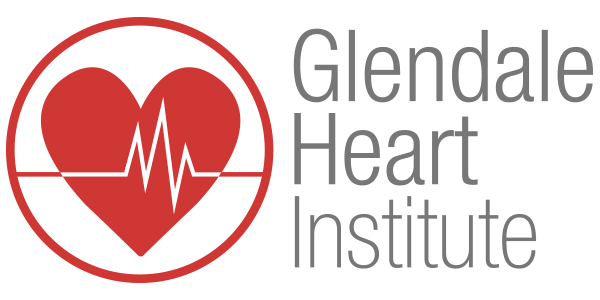A biventricular pacemaker is a special pacemaker used for cardiac resynchronization therapy in heart failure patients.
How Does a Bi-VICD Work?
Leads are implanted through a vein into the right ventricle and into the coronary sinus vein to pace or regulate the left ventricle. Usually (but not always), a lead is also implanted into the right atrium. This helps the heart beat in a more balanced way.
Traditional pacemakers are used to treat slow heart rhythms. Pacemakers regulate the right atrium and right ventricle to maintain a good heart rate and keep the atrium and ventricle working together. This is called AV synchrony. Biventricular pacemakers add a third lead to help the left ventricle contract at the same time as the right ventricle.
How do I Prepare for the Bi-Ventricular Pacemaker Implant
After the pacemaker implant, you will likely be admitted to the hospital overnight. The nurses will monitor your heart rate and rhythm. You will also have aa telemetry monitor attached with small electrode patches. It will record your heart rhythm for about 12 hours. This is another way to check proper pacemaker function. The morning after your implant, you will have a chest x-ray to check your lungs and the position of your pacemaker and leads.
How Does a Bi-VICD Work?
Leads are implanted through a vein into the right ventricle and into the coronary sinus vein to pace or regulate the left ventricle. Usually (but not always), a lead is also implanted into the right atrium. This helps the heart beat in a more balanced way.
Traditional pacemakers are used to treat slow heart rhythms. Pacemakers regulate the right atrium and right ventricle to maintain a good heart rate and keep the atrium and ventricle working together. This is called AV synchrony. Biventricular pacemakers add a third lead to help the left ventricle contract at the same time as the right ventricle.
How do I Prepare for the Bi-Ventricular Pacemaker Implant
After the pacemaker implant, you will likely be admitted to the hospital overnight. The nurses will monitor your heart rate and rhythm. You will also have aa telemetry monitor attached with small electrode patches. It will record your heart rhythm for about 12 hours. This is another way to check proper pacemaker function. The morning after your implant, you will have a chest x-ray to check your lungs and the position of your pacemaker and leads.

What to Expect After Bi-Ventricular Pacemaker Implantation
Expect to stay in the hospital overnight so your health care team can check your heartbeat and make sure your pacemaker is working well. You’ll likely have to arrange for a ride to and from the hospital because your doctor may not want you to drive yourself.
For a few days to weeks after surgery, you may have pain, swelling, or tenderness in the area where your pacemaker was placed. The pain usually is mild; over-the-counter medicines often can relieve it. Talk to your doctor before taking any pain medicines.
Your doctor may ask you to avoid vigorous activities and heavy lifting for about a month after pacemaker surgery. Most people return to their normal activities within a few days of having the surgery.
Expect to stay in the hospital overnight so your health care team can check your heartbeat and make sure your pacemaker is working well. You’ll likely have to arrange for a ride to and from the hospital because your doctor may not want you to drive yourself.
For a few days to weeks after surgery, you may have pain, swelling, or tenderness in the area where your pacemaker was placed. The pain usually is mild; over-the-counter medicines often can relieve it. Talk to your doctor before taking any pain medicines.
Your doctor may ask you to avoid vigorous activities and heavy lifting for about a month after pacemaker surgery. Most people return to their normal activities within a few days of having the surgery.
Cardiac Specialty Care
• Structural Heart Disease
• TAVR Aortic Valve
• Cardiomem - Heart Failure
• Coronary Disease
• TAVR Aortic Valve
• Cardiomem - Heart Failure
• Coronary Disease
• Complex total Occlusions
• Stent and PTCA
• Atherectomy
• Cerebral
• Stent and PTCA
• Atherectomy
• Cerebral
• Carotid Stenting
• Peripheral Arterial
• Atherectomy-Stent-Thrombectomy
• Peripheral/Venus - Ablation - DVT thrombectomy - IVC filter
• Peripheral Arterial
• Atherectomy-Stent-Thrombectomy
• Peripheral/Venus - Ablation - DVT thrombectomy - IVC filter
• Rhythm Management
• Pacemaker
• Resynchronization Therapy
• EECP- Enhance electrical Counterpulsation
• Pacemaker
• Resynchronization Therapy
• EECP- Enhance electrical Counterpulsation
